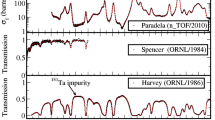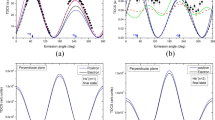Abstract
In this paper, we calculate the nuclear stopping powers for the H, D, T–Be, C, W systems that are necessary for calculating the plasma-wall interaction in thermonuclear research, as well as for the Kr–Si, Kr–Ge, O–Si systems used for ion implantation in semiconductors using interaction potentials obtained in the framework of density-functional theory. In the range of collision energies of 10–1000 eV, the obtained data differ from the SRIM data by 15–70%. The presence of a potential well leads to the appearance of an additional peak in the dependence of the nuclear stopping cross section at low energies. A comparison of the classical calculations of the transport cross section with the semiclassical ones shows their identity at energies up to 0.3 eV.





Similar content being viewed by others
REFERENCES
J. Lindhard, M. Scharff, and H. E. Schiott, Mat.-Fys. Medd.—K. Dan. Vidensk. Selsk. 33, 1 (1963).
Improvement of the Reliability and Accuracy of Heavy Ion Beam Analysis, Technical Reports Series, No. 485, Ed. by A. Simon (IAEA, Vienna, 2019.)
A. N. Zinoviev, Nucl. Instrum. Methods Phys. Res., Sect. B 269, 829 (2011). https://doi.org/10.1016/j.nimb.2010.11.074
A. N. Zinoviev and K. Nordlund, Nucl. Instrum. Methods Phys. Res., Sect. B 406, 511 (2017). https://doi.org/10.1016/j.nimb.2017.03.047
S. R. Naqvi, G. Possnert, and D. Primetzhofer, Nucl. Instrum. Methods Phys. Res., Sect. B 371, 76 (2016). https://doi.org/10.1016/j.nimb.2015.09.048
H. Grahmann and S. Kalbitzer, Nucl. Instrum. Methods Phys. Res. 132, 119 (1976). https://doi.org/10.1016/0029-554X(76)90720-5
D. Jedrejcic and U. Greife, Nucl. Instrum. Methods Phys. Res., Sect. B 428, 1 (2018). https://doi.org/10.1016/j.nimb.2018.04.039
R. Shnidman, R. M. Tapphorn, and K. N. Geller, Ap-pl. Phys. Lett. 22, 551 (1973). https://doi.org/10.1063/1.1654504
L. G. Glazov and P. Sigmund, Nucl. Instrum. Methods Phys. Res., Sect. B 207, 240 (2003). https://doi.org/10.1016/S0168-583X(03)00461-0
Th. Krist, P. Mertens, and J. P. Biersack, Nucl. Instrum. Methods Phys. Res., Sect. B 2, 177 (1984). https://doi.org/10.1016/0168-583X(84)90183-6
P. S. Krstic and D. R. Schultz, Phys. Plasmas 13, 053501 (2006). https://doi.org/10.1063/1.2199808
D. R. Schultz and P. S. Krstic, Phys. Plasmas 9, 64 (2002). https://doi.org/10.1063/1.1419056
H. Ryssel and I. Ruge, Ion Implantation (Wiley, Chichester, 1986; Nauka, Moscow, 1983).
L. D Landau and E. M. Lifshits, Quantum Mechanics (Nauka, Moscow, 1989) [in Russian].
N. F. Mott and H. S. W. Massey, The Theory of Atomic Collisions (Clarendon, Oxford, 1949; Mir, Moscow, 1969).
A. N. Zinoviev, Tech. Phys. 53, 13 (2008). https://doi.org/10.1134/S1063784208010039
DMol Software, 1997.
D. S. Meluzova, P. Yu. Babenko, A. P. Shergin, K. Nordlund, and A. N. Zinoviev, Nucl. Instrum. Methods Phys. Res., Sect. B 460, 4 (2019). https://doi.org/10.1016/j.nimb.2019.03.037
A. N. Zinoviev, P. Yu. Babenko, and K. Nordlund, Nuc-l. Instrum. Methods Phys. Res., Sect. B 508, 10 (2021). https://doi.org/10.1016/j.nimb.2021.10.001
Y. R. Luo, Comprehensive Handbook of Chemical Bond Energies (CRC, Boca Raton, 2007). https://doi.org/10.1201/9781420007282
B. Darwent, Bond Dissociation Energies in Simple Molecules (Natl. Bureau Stand., Washington, DC, 1970).
A A. Radzig, B. M. Smirnov, Reference Data on Ato-ms, Molecules, and Ions (Springer, Berlin, 1985).
B. P. Nikol’skii, Chemist’s Handbook (Khimiya, Leningrad, 1966), Vol. 1.
NIST Data Base. https://webbook.nist.gov/chemistry.
J. F. Ziegler, J. P. Biersack, and U. Littmark, The Stopping and Range of Ions in Solids (Pergamon, New York, 1985), Vol. 1.
J. F. Ziegler and J. P. Biersack, SRIM. http://www.srim.org.
P. Yu. Babenko and A. N. Zinoviev, Tech. Phys. 67, 1 (2021). https://doi.org/10.1134/S1063784222010029
O. B. Firsov, Zh. Eksp. Teor. Fiz. 7, 308 (1958).
Author information
Authors and Affiliations
Corresponding author
Ethics declarations
The authors declare that they have no conflict of interest.
Additional information
Translated by A. Ivanov
Rights and permissions
About this article
Cite this article
Babenko, P.Y., Zinoviev, A.N. Nuclear Stopping Powers for DFT Potentials with an Attractive Well. J. Surf. Investig. 17, 1267–1272 (2023). https://doi.org/10.1134/S1027451023060058
Received:
Revised:
Accepted:
Published:
Issue Date:
DOI: https://doi.org/10.1134/S1027451023060058




